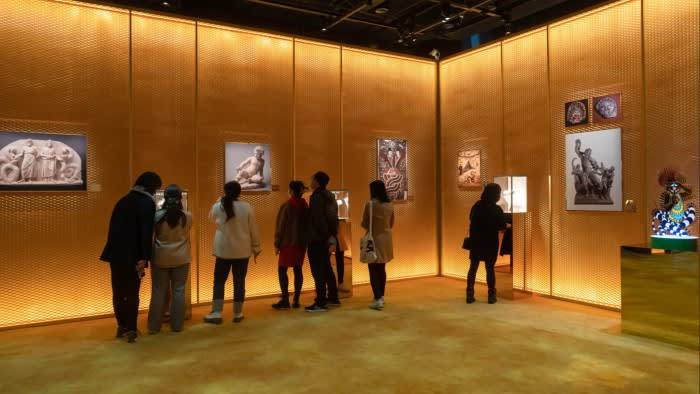The Roman god Janus, with his two faces looking in opposite directions, aptly represents the duality of the jewellery market: one-of-a-kind fine jewellery pieces with sky-high price tags (typically above £80,000) for wealthy buyers, and accessible items often under £1,000 for aspirational clients. But, now, a new focus is emerging somewhere between these extremes: mid-priced jewellery, ranging from £10,000 to £100,000.
In April last year, during Milan Design Week, Cartier introduced its new Tressage collection, starting at £11,400 for a ring topped with a multitude of golden beads.
Later in the year, Gucci took over the Savoy hotel in London to showcase Flora, a range of mid-priced jewellery featuring pavé diamonds and coloured gemstones in depictions of vegetal motifs that riff on the house’s archives.
At Louis Vuitton, its four-leaved, custom-cut diamond echoing the house’s logo was the central theme of LV Diamonds, a series of premium designs featuring the LV Monogram Star with prices into five digits.
Brands’ favoured approach to expanding their mid-range offer, though, is to enhance entry-price designs or adapt high jewellery pieces at more accessible price points. Bulgari, for example, keeps unveiling new, more abstract and less expensive renderings of its successful zoomorphic snake from its high jewellery Serpenti creations.
Meanwhile, Chaumet is continuously reinterpreting its three core collections — Joséphine, Bee My Love, and Liens — attract clients at various price points, from entry-level to mid-range.
Mid-priced jewellery accounts for about a fifth of the French house’s jewellery offering and, according to Claudia D’Arpizio, global head of fashion and luxury at consultants Bain & Co, mid-priced jewellery can represent 30-70 per cent of a brand’s turnover. She ascribes the segment’s expansion to the overall growth in the jewellery sector.
“Over the past five to 10 years, growth has been spread across all segments,” she says. “Post-Covid, high jewellery has been on a general outperforming trend, gaining further edge more recently. For the remainder of the market, growth has been brand-driven rather than segment-driven, with several brands able to play ‘high-low’ with their value proposition, intercepting customers across all price points.
“We see the growth of a ‘newer’ segment that can be defined as ‘medium-high priced’ jewellery, stretching from the traditional core offer of gemstones and gold, with less elaborated styles, up to ‘repeatable high-end jewellery’.”
Cynthia Tabet, global product marketing director at Piaget, says “the goal for every maison is to create bridges between different categories, but also to attract new clients”. She thus highlights the critical function of mid-priced jewellery in a brand’s portfolio: to showcase the house’s signature design language and craft.
In April, to celebrate the brand’s 150th anniversary, Piaget unveiled a new capsule collection of its Possession range that takes the successful entry-price design and elevates it with the gold-engraving techniques and chain motif typical of its high-end jewellery and watchmaking.

That view is shared by Mauro di Roberto, Bulgari’s jewellery managing director. “The medium-priced jewellery segment is pivotal for luxury brands, as it helps maintain image while expanding client base and market reach,” he says. “It can attract a wider audience, introduce new customers to the maison’s aesthetic, values and customer experience, and foster brand loyalty that could translate into future high-end sales.”
As established houses enrich their offer and new players enter the market, mid-priced jewellery is becoming the new entry point for high jewellery clients.
“Purchasing medium-priced jewellery allows clients to become acquainted with the maison and its offerings, while it helps them build trust in the quality and service of Bulgari without making a significant financial commitment,” says Di Roberto.
For a house such as Gucci, mid-priced jewellery sold through a network of retailers serves as an ambassador category for the brand’s high-end image and attracts new customers — particularly in regions where it doesn’t have a presence in fashion retail.

From a financial perspective, mid-priced pieces provide solid returns for jewellers because there is not the negotiation on price that there can be with high jewellery. “The situation for medium-priced jewellery is closer to that of entry prices, with list prices that are ‘not negotiable’ and pricing structures that are set to preserve target margins,” says D’Arpizio.
Large houses face competition, however. Mid-priced jewellery is the favoured arena for independent jewellery artists — such as Fabio Salini, Otto Jakob or Lily Gabriella — who, over the years, have nurtured a dedicated clientele looking for bespoke and one-of-a-kind creations.
Creating successful mid-priced pieces also presents design challenges. “Designing a medium-priced jewellery collection involves a delicate balance between quality, aesthetics and cost-efficiency,” says Di Roberto. “The goal is to create jewellery that represents the DNA, unique design, high craftsmanship standards and high-quality performance with the right price positioning.
“This approach influences numerous design aspects related to material selection, craftsmanship and, ultimately, the complexity of the jewel.”
Tabet at Piaget echoes this. “In a nutshell, you have all the constraints of the high jewellery department fused with the marketing and pricing constraints of the fine jewellery,” she says. But the rewards seem worth the effort, echoing an old Roman saying: in medio stat virtus (virtue lies between extremes).


